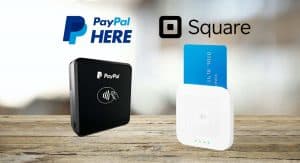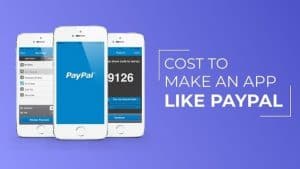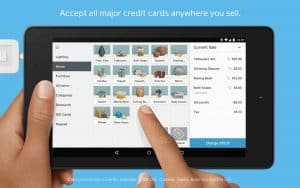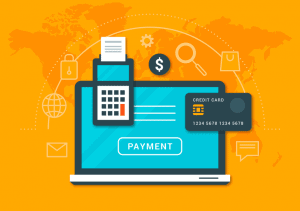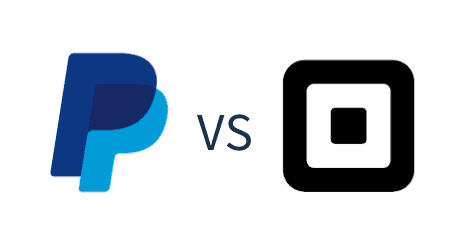
PayPal is a well-established POS system that serves nearly every vertical by helping them accept and make payments. Top-of-the-line security features like fraud and seller protection help you manage your risk. The platform allows for both in-person and online payments, build loyalty programs, create and analyze reports, and more.
Square is one of the most popular POS systems on the market, due to its fast setup and ease of use. The free POS version contains the basic features your business needs, including accepting payments, tracking purchases, managing inventory and more. There are also add-ons for an additional fee, including transactional emails, shipping labels, and more.
In our research for this PayPal vs. Square comparison, we found that PayPal offers a more versatile POS system that works for online and service-based businesses. Square, on the other hand, is better suited for managing physical inventory and in-person transactions.
Both platforms, at their most basic models, do not require a subscription fee. However, they do charge for each transaction, and they both charge the same amount: 2.9% + $0.30 on each transaction.
No matter which of these you choose, PayPal and Square are both solid choices for payment processing, customer engagement, and revenue management. Let’s dive into each provider’s features, pricing, and support.
Overview of the Two Processors
PayPal and Square have a lot in common. They are both developer-friendly platforms that come with a lot of flexibility.
PayPal

Square

Key Features
 |
||
|---|---|---|
| POS Software | ||
| Payment Processing | ||
| Online Payments | ||
| Hardware | ||
| Operating System | ||
| Analytics and Reporting | ||
| Employee Management | ||
| Customer Service | ||
| Integrations | ||
| Security |
Additional Services
Both payment processors offer other popular features you might not find anywhere else. A few of these include:
Square
Square Appointments
- Multilocation Management
- Advanced Reporting
- Team Management
- Loyalty Program
PayPal
Product Catalog
- Automatic Invoicing
- Optimized Checkout
- Inventory Management
- PayPal Mastercard
Hardware
Square and PayPal have similar terminals, but PayPal tends to be more complicated. The main difference between the two is that the Square Reader will only accept contactless and chip payments. The PayPal card reader accepts contactless, chip, and magnetic stripe cards. Both systems will take:
- Visa, Mastercard, Amex, Discover
- Debit card
- Cash
- Check
- Mobile wallets (Apple, Samsung, and Google)
Square Hardware
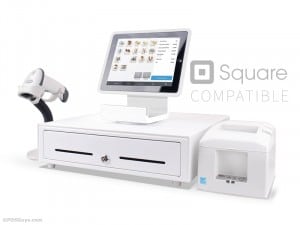
- Square Reader for Magstripe – Free with account and $10 for each additional reader.
- Square Reader for Chip and Magstripe – $35 per module.
- Square Reader for Chip and Contactless Payment – $49 per module.
- Square Stand – $169 (not including the iPad).
- Square Register – $799 for a fully equipped system.
Square has thought of it all. The first three options are mobile and reliant on a smart device. The last two are countertop POS systems. The Register comes completely equipped with software and is ready to use at any time.
Square also gives a business the ability to mix and match hardware to build the perfect system. All card readers function with the free, Square POS app on an iPhone, iPad, or Android device.
PayPal Hardware
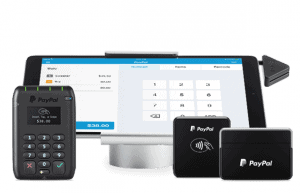
- Chip and Swipe PayPal Credit Card Reader – $14.99 (headphone jack, magstripe)
- Chip and Tap PayPal Credit Card Reader – $24.99 (Bluetooth enabled chip and magstripe)
- Chip PayPal Credit Card Reader – $99.99 (comes with a keypad)
- Mobile PayPal Credit Card Reader – $14.99 (headphone jack, magstripe)
The most popular model is the PayPal Chip and Swipe Reader. An all-inclusive option is the Chip Credit Card Reader. It accepts swipe, chip, and NFC transactions and comes with a complete keyboard for easy pin entry.
These readers comprise the whole of PayPal Here hardware options. All are mobile, non-countertop POS systems that rely on a smart device to make things happen.
PayPal vs. Square Hardware
In comparison, the two products that most align are the mid-range models: Square Reader for Contactless Chip and the PayPal Chip and Tap Reader. Keep in mind, neither of these options has a built-in receipt printer or cash drawer. Those must be purchased separately.
When it comes to hardware, the main difference between the two brands is that the PayPal Readers accept chip, contactless, and magnetic stripe while Square equipment only accepts chip and contactless payment.
The main thing to remember between the two systems is that Square typically comes optimized and ready to go while PayPal takes some setting up and installation. If you’re looking for a countertop device or a full-service system, Square might work best for your business.
When comparing the main hardware of both brands, there are some key differences:
| Internet Connection | ||
| Card Technology | ||
| Online/Offline | ||
| Keypad | ||
| Display | ||
| iOS/Android App |
Software
If you need a POS system for your brick and mortar store, both Square POS and PayPal Here are the perfect solution. If it’s online payments you seek (like ecommerce) you should look into Square Payments and PayPal web payments.
PayPal Software
All PayPal equipment runs off the free, mobile POS app called PayPal Here. When paired with a card reader, vendors can process in-person payments through a smart device. You can customize business profiles and receipts, record cash, and calculate sales tax. Additional features include:
- Send invoices
- Record cash and check transactions
- Create a product list with pictures
- Employee roles and permissions
- In-depth reporting and analytics
PayPal Checkout
This feature enables a business to add a PayPal payment module directly to a business website or ecommerce store. It gives customers the option to pay with:
- PayPal
- Venmo
- Credit cards
- Debit cards
Users can complete a purchase without ever leaving your site. One thing to note is that a developer is required to add PayPal Checkout to a unique site. However, if a business is equipped with ecommerce software, you may have the feature already integrated. All you need to do is add it.
Like Square Payments, there is no monthly fee to use PayPal Checkout.
PayPal Payments Standard
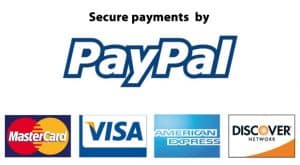
Unlike the PayPal Checkout feature, customers do not stay on your site for the entire payment process. However, PayPal Payments Standard can be integrated with all major ecommerce and shopping cart platforms. There is no monthly fee for this feature. You simply pay the same fees for every transaction.
Payment Methods
PayPal offers more ways to pay than Square, namely PayPal Check-In payments through the Here platform. Customers with an account can find your business through their personal PayPal app and “check in” under the listing. You can then charge the payer’s PayPal account through your app. This costs the same rate as domestic cards run through the reader.
Please note, PayPal accepts PayPal transactions, but Square does not. This is only relevant for online payments, as this is what is popular among PayPal’s customers.
Square Software
Square Point of Sale is the brand’s main product and is built into the Square Reader. It’s a complete POS system that will integrate with a cash drawer and receipt printer. The software platform can be downloaded on both iOS and Android devices and comes with key features like:
- Employee management and time tracking
- Invoicing and billing
- Real-time analytics
- Customer directory
- Tab and tip reconciliation
Deposits from Square POS hit your bank account in one to two business days. Square POS always gives you the option to integrate with third-party apps and accepts payments both online and offline.
Square for Retail
Square has designed a POS system specifically for retail businesses. There is a tiered payment system with free, $60, and $299 per month packages. The product has retail-related features like:
- Extensive inventory management and tracking
- Elevated customer relationship capabilities (CRM)
- In-app purchase orders
- Keyword and barcode scanning
- Exchange and return processing
The product also has unlimited staff permissions and vendor management.
Square for Restaurant
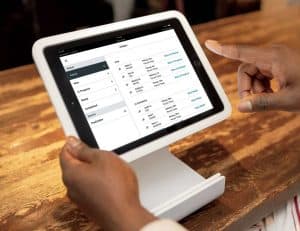
- Table maps and seat tracking
- Quick check splits and repeat orders
- Coursing and BOH communication
- Conversational order modifiers
- Automatic gratuity
The system will also give a business dining options like “for here,” pickup, or delivery.
All Square software enables a business to turn the system into a virtual terminal and manually enter payment information.
In comparison, the PayPal app provides the basics needed to accept orders and process payments. The Square platform offers extensive features that a smaller business may not need.
Cost
Here is a breakdown of PayPal vs. Square costs:
 | ||
|---|---|---|
| Setup Fee | ||
| Card Reader | ||
| Countertop Terminal | ||
| Monthly Fee / Setup Fee | ||
| Online Payment | ||
| Swipe/Dip/Tap | ||
| Virtual Terminal/Manual | ||
| Chargeback Fee | ||
| Recurring Payment | ||
| Additional App Fees | ||
| International Card Fee | ||
| Currency Conversion Fee | ||
| Refunds | ||
| Instant Transfer |
International Payments
Square and PayPal both have a fixed rate for swipe, EMV, and contactless payments. So, who is cheaper? That all depends on a company’s financial behavior. The price of the platform can change depending on whether you accept foreign-issue cards, process refunds regularly, or have more chargebacks than the average vendor. In this case, PayPal can get costly.
Square fees are simpler than PayPal because they don’t differentiate between countries. The fee always stays the same. PayPal can pile on the charges if the transaction doesn’t involve a Visa, Mastercard, Amex, or Discover.
For a foreign-issue card, you pay the 2.7% base rate plus 1.5% for the fact it is foreign. Then, they tack on a 2.5% currency conversion rate. This can add up to a rate of 6.7% whereas Square doesn’t apply any currency conversion fee at all.
It should be noted, as a registered user in the United States, a merchant can only accept transactions in U.S. dollar amounts.
Manual Payments
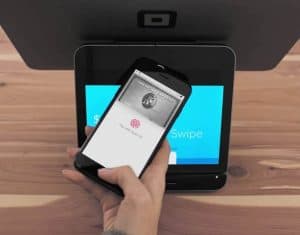
Refunds
Square does not charge a fee to process refunds. The receiver gets the full amount including the transaction fee Square kept with the original payment. PayPal, however, charges the original transaction fee (including currency conversion and cross-border) for any refunded payments.
Chargebacks
Chargebacks do not incur a fee with Square, but the payment amount will be held until the dispute is resolved. PayPal also holds the amount until the case is resolved. Still, it should be noted that PayPal charges $20 per chargeback.
Transfers
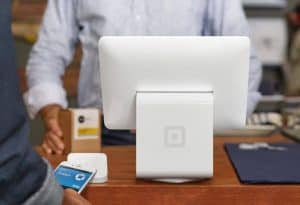
Those who want to spend the PayPal balance immediately can apply for the PayPal Business Debit Mastercard. This can be used in ATMs for cash withdrawals and anywhere Mastercard is accepted.
Square transfers directly to your bank account. They do not hold funds in an online account. Transactions tend to clear within 1-2 business days. For an extra 1% fee, you can receive money within 20 minutes. This is called an instant transfer.
PayPal Here sends deposits to your bank account within minutes. This will cost 1% on top of the card fees but you still have to manually withdraw funds from the account.
PayPal and Square fees are similar except for when it comes to in-person payments. In this instance, PayPal has more costs involved. Online payments typically cost the same for both platforms.
Customer Service and Support

Square Support
- Phone and Email – You can only reach Square’s support team through a code. Users with terminated accounts report having a hard time getting anyone on the phone.
- Social Media – Square’s Twitter feed is live and active. Their YouTube channel is also full of instructional and helpful videos.
- Help Center – Square has an online knowledgebase that covers every detail of the platform.
- Seller Forum – A community of peers you can search for advice. It is also run by Square staff who are quite active.
PayPal Support
- PayPal Hub – The help center is organized by topic so you can easily search FAQs.
- Social Media – PayPal is on both Facebook and Twitter to answer questions in real-time.
- Phone and Email – Phone support can be inconsistent, so the help center is a good place to start. You can also email the help desk.
- PayPal Seller Forum – A community of peers that give advice and answer questions.
The Verdict
It can be easier to choose Square because of the advanced features they offer and niche solutions (like retail and restaurant). PayPal can integrate with other checkout systems but it’s not as user-friendly as Square. However, merchants who prefer the best face-to-face sales opportunities may prioritize PayPal here.
When Square Wins
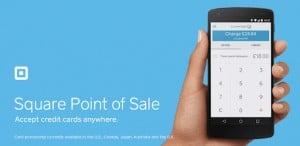
When compared to PayPal Here, Square offers three different types of POS systems. They all come with more features than PayPal which includes customer insights and employee management tools.
When looking at online credit card processing, system comparison becomes more difficult. Although PayPal is considered an expert in the space, there’s no reason to write off Square Payments.
The processing rates for both platforms are virtually the same, but if you are looking to accept payments in-person, Square is the better choice. The program enables a brand to keep all payment processing, business operations, and tools in a single spot. Any company can benefit from this type of cohesive resource.
When PayPal Wins
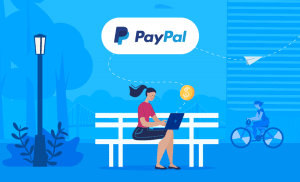
Unlike Square, PayPal has the benefit of allowing you to offer customers the platform as a form of payment. It’s also the payment integration you will see most frequently on ecommerce websites. This makes it a much easier and effective way to connect with buyers.
Additionally, if you’re already using PayPal’s online payment processing it might be easier to use PayPal Here. Where Square is an “all-in-one” solution, the PayPal Here app works more as a supplement to a PayPal business account. It’s ideal for processing a one-off, in-person payment.
It should be noted, although the processing fees for both platforms are similar, PayPal is more affordable for a business making smaller transactions. However, the hardware and software PayPal provide is not always enough to serve as a full-fledged point of sale system for a high-volume business.
Who to Choose?
In the long run, it’s hard to go wrong with either system. They are both reliable payment service providers with top-notch options for a small business. Both offer online and mobile-based technology that makes payment processing easier than ever!
The choice you make will ultimately boil down to direct business needs. If your store relies on in-person transactions that require a robust point of sale system, you might choose Square for the multiple software and hardware options.
If you already process payments through PayPal and only need in-person transactions on occasion, PayPal Here will easily give you this functionality.
There’s no doubt that both systems will suit a business quite well. After research, if you are still unsure, talk to Square and PayPal directly or run a test on each one. Neither product requires a long-term commitment, set up, or cancellation fee so feel free to explore as much as possible prior to making a decision.

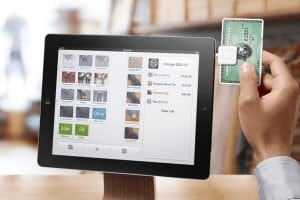 Square Appointments
Square Appointments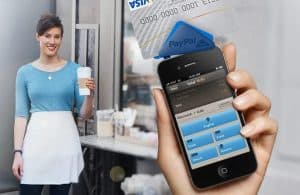 Product Catalog
Product Catalog